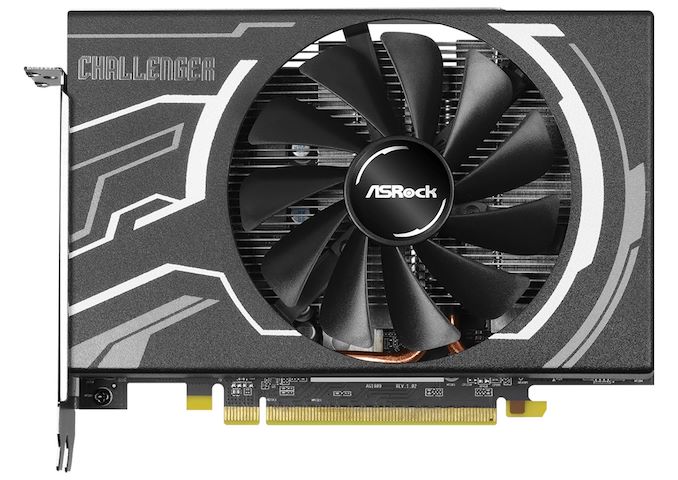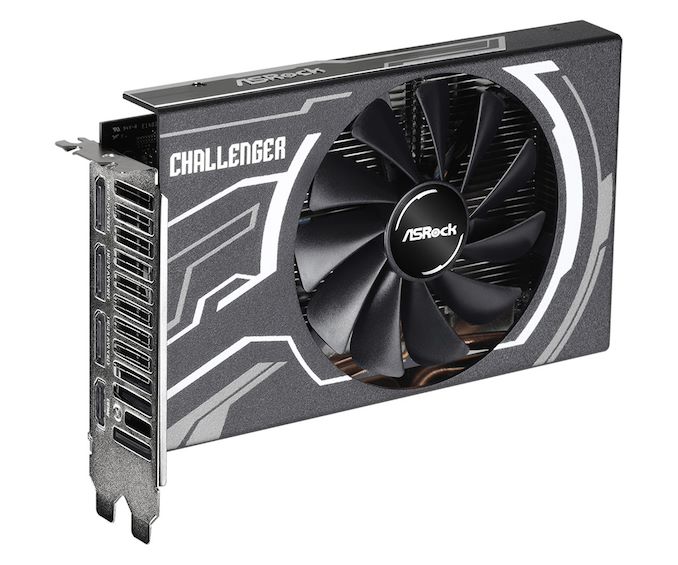ASRock Unveils Radeon RX 5500 XT Challenger ITX 8 GB Graphics Card
by Gavin Bonshor on April 16, 2020 2:00 PM EST- Posted in
- GPUs
- Radeon
- ASRock
- Mini ITX
- Navi
- 7nm
- RX 5500 XT
- Challenger ITX
 jpg_678x452.jpg)
ASRock has announced its latest ITX graphics card for small form factors, the Radeon RX 5500 XT Challenger ITX. This new mini-ITX card is based on AMD's Navi 14 GPU and offers 8 GB of GDDR6 memory attached to a 128-bit bus, with the same core and memory clock speeds as a reference model.
Finding a graphics card for a small form factor system can be tiresome with very little on the market to choose from. One of the big trade-offs of graphics cards designed for small form factor systems is that beefier models such as AMD's RX 5700 XT, and NVIDIA's GeForce RTX 2080 Ti are too large in design to accommodate such a small PCB, which is where smaller cards designed particularly for the ITX form factor come in.
Focusing on the ASRock RX 5500 XT Challenger ITX 8G, it is very small for its power with dimensions of 190 x 139 x 42 mm, meaning that it is just under 7.5 inches in length. It features a single 10 cm cooling fan on its front, embedded in a white and silver dual-slot cooler, which is designed to direct hot air out of the rear of a chassis. The cooler on the ASRock RX 5500 XT Challenger ITX 8 G is actually longer than a reference model (7.5 vs 7.1 inches) but is still much smaller than most aftermarket designs from other vendors.
Physical size aside, the card is very similar in specifications to other 5500 XT cards on the market. The Challenger ITX ships with a base core clock of 1607 MHz and acn boosts up to 1845 MHz. Meanwhile the effective memory core clock speed of 14 Gbps. Unsurprisingly then, with its reference-like clocks, the card is targeted towards 1080p gaming.
As for display outputs, ASRock has outfitted the card a trio of DisplayPort 1.4 connectors as well as a single HDMI 2.0b port. Feeding the mini monster is a single 8-pin 12 V ATX PCIe power connector, which is more than sufficient to meet its 130 W TDP.
ASRock hasn't announced when the Radeon RX 5500 XT Challenger 8G will be available at retailers, nor has it provided any information about its price.
Related Reading
- The AMD Radeon RX 5500 XT Review, Feat. Sapphire Pulse: Navi For 1080p
- ASUS Launches An Old GPU: The NVIDIA GT710 with Four 4K HDMI Ports
- EVGA Announces GeForce RTX 2070 Super KO & RTX 2080 Super KO
- NVIDIA's GeForce GTX 1650 GDDR6 Released: GDDR6 Reaching Price Parity With GDDR5
- PowerColor Extends Product Warranty by Three Months Due to Coronavirus
Source: ASRock












62 Comments
View All Comments
flyingpants265 - Monday, April 20, 2020 - link
100% completely false info.Valantar - Tuesday, April 21, 2020 - link
I've seen ebough tiny builds with 2080Tis (and 1080Tis before that) and various high end CPUs to know for a fact that is entirely false. Go over to the SFF Network forums and have a look. You'll learn something.Reflex - Sunday, April 19, 2020 - link
Yup, I've got the Dan A4 with a Ryzen 2700X, 32GB PC3000 & MSI GTX1080 from early 2018. It's nearly silent and slays anything I throw at it.There is no need to compromise in this space.
Koenig168 - Thursday, April 16, 2020 - link
mATX is neither here nor there. ITX for a sleek profile or ATX for a full-sized rig makes more sense.deil - Friday, April 17, 2020 - link
Yup. Most people want EITHER small or powerful. Not many can compromise in kind of smaller but em not really. And itx to mATX is not gaining much as they both end up with 240 water AIO at best.a bit less hassle with cables, but 22l itx box with custom cables provided is even easier to build than full atx.
AdditionalPylons - Friday, April 17, 2020 - link
It is of course a matter of personal needs, but I quite like mATX. I often find the single PCIe slot of mITX limiting. But I still think you are right about most people choosing either mITX or ATX.Then there are also a few ATX cases which are smaller than many mATX cases. I remember making a nice i7-3770 build many years ago in the cheap and compact CoolerMaster Elite 361, which is a 25.6L ATX case! It had its PSU cleverly located in the front.
DanNeely - Friday, April 17, 2020 - link
It's less the single PCIe slot (I think the last time I had 2 cards installed were SLI GTX260's a decade ago) that's always had me avoiding mITX than it has been everything else.The biggest issue is that a lot of my boxes eventually end up with 4 sticks of ram because going from 2 to 4 is the cheapest way to double capacity, and without going SoDIMM and taking a performance/high end capacity hit in doing so mITX is normally limited to 2 slots.
Beyond that lower margins for overclocking due to limited space for power options, generally needing kludgy setups to have room for multiple M.2 drives (wasn't an issue last build, will be in the future), along with a price premium for higher end mITX boards(not sure if still an issue, but it was a few years ago) always put me off them.
I have nothing against mATX; but lower product volumes make trying to find a board with all the features I want tricky (last time around the biggest missing feature eliminator was dual USB3 headers) for my primary system, and unless i go all in I still need to buy full ATX cases to be freely able to swap parts around. (At present I'm maxed out on the number of boxes I run, so it effectively means that even if I got new mATX boards I'd still be reusing old full ATX cases unless I wanted to spend extra for otherwise unneeded replacements.)
Selicos - Friday, April 17, 2020 - link
That makes sense. I stick to ITX but have plenty of RAM from the start, at least based on my current and planned future usage. I've offloaded tasks and storage to a NAS and VM box with only a GPU upgrade planned for this system before a full refresh in 2-3 years. That will probably mean a jump to DDR5 (hopefully) and other advances.amnesia0287 - Sunday, April 19, 2020 - link
For the record, using 4 sticks instead of 2 will impact performance to a degree, though only if you are trying to use really fast memory. But if you are building a kit fresh, you can easily get 32gb in 2 sticks and I don’t see how anyone NEEDS more. Almost nothing but chrome will use the extra ram.DanNeely - Sunday, April 19, 2020 - link
2 dimms/channel is only a percent or two; if you're sacrificing timing numbers to get a bigger size you're going to end up behind.And when I built my last system 5 years ago fast 16gb DDR3 was either stupidly expensive or not available at all. Since it's only available at DDR3-1600 now I'm assuming the latter. Even if faster higher capacity dimms had became available in the interim, I was already bumping off the 18gb I had in my previous LGA-1366 box (3 channels, 4+2 in each); waiting for higher capacity fast dimms that never came wasn't an option.
If I were to build now, 2x32 GB looks pretty sweet if I went with a basic 8/16 core setup. If I were to splash out on a Ryzen 16/32 I think I'd want 128gb for headroom. It'd be running Einstein @ Home during it's idle cycles; and while the current CPU app needs about 1.3gb/core which is probably manageable, based on past history it'll probably grow to ~2.5gb/core during the systems lifetime at which point 64gb won't be enough even if it gets semi-retired from my main system to a dedicated crunchbox. While I doubt I'd spashout $750 for that chip today, 2 years from now I suspect it'll be the $300-400 option I do go for. Which means unless big capacity dimm ram prices drop a lot I'll be going 4x32 for a 2/channel setup again.